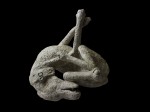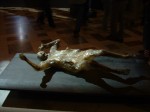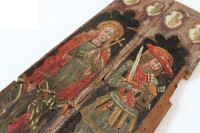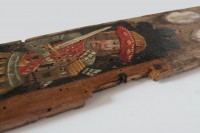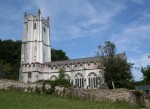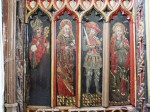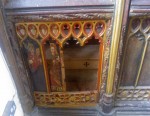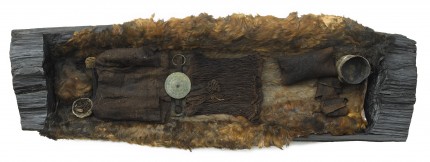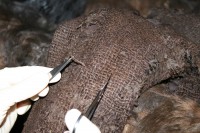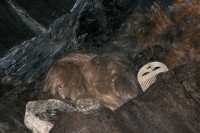![]() The 13th century icon of the Madonna in the Basilica of Saints Boniface and Alexis on the Aventine Hill has been restored to glowing golden splendor. The restoration by experts at the Superior Institute for Conservation and Restoration (ISCR) took three years. The surface was cleaned, pollutants and paint from past retouchings removed.
The 13th century icon of the Madonna in the Basilica of Saints Boniface and Alexis on the Aventine Hill has been restored to glowing golden splendor. The restoration by experts at the Superior Institute for Conservation and Restoration (ISCR) took three years. The surface was cleaned, pollutants and paint from past retouchings removed.
This isn’t the first time the ISCR has worked on this icon. In 1951 it was restored by Cesare Brandi, ISCR founder and pioneer art restorer. The icon was in dangerously bad condition due to the decay of the wood panel on which it was originally painted. Brandi transferred the work to canvas and filled in areas of missing paint using a thin watercolor cross-hatching technique he had pioneered in the restoration of the frescoes in the church of Saint Mary of the Truth in Viterbo after they were reduced to rubble by an Allied bomb in 1944.
![]() The next time the icon left the church was in 2012 for an exhibition of 14 of Rome’s medieval icons at the Palazzo Venezia. That’s where it became clear that Brandi’s retouchings had become problematic over the six decades. ISCR restorers removed paint from Brandi’s and previous interventions. The small gaps were then filled by being covered with tissue paper and painted with watercolor, the larger gaps by stucco and cross-hatch paintings. The technique Brandi used is still a staple of art restoration today; it’s the materials and analytic technology that have improved by leaps and bounds.
The next time the icon left the church was in 2012 for an exhibition of 14 of Rome’s medieval icons at the Palazzo Venezia. That’s where it became clear that Brandi’s retouchings had become problematic over the six decades. ISCR restorers removed paint from Brandi’s and previous interventions. The small gaps were then filled by being covered with tissue paper and painted with watercolor, the larger gaps by stucco and cross-hatch paintings. The technique Brandi used is still a staple of art restoration today; it’s the materials and analytic technology that have improved by leaps and bounds.
Cesare Brandi also restored other famous icons in Rome, including the Madonna of Ara Coeli, an 11th century tempera on wood panel which replaced a masterpiece by Raphael on the high altar of the church of Ara Coeli on the Capitoline Hill, and the Madonna of San Sisto, now at the monastery of Santa Maria del Rosario in the Monte Mario neighborhood, which dates to the 7th century and is the oldest icon in the city.
![]() The Madonna di Sant’Alessio icon was painted by an unknown Roman artist in the mid-13th century in the style of the Advocate Madonna, an iconographic type emphasizing Mary’s intercessionary role on behalf of humanity that was very popular in medieval Rome. For a few centuries before and after the first millennium, the Advocate Madonna type, depicted without the Christ child, her right hand raised, her left against her chest, was considered the quintessential Roman Madonna.
The Madonna di Sant’Alessio icon was painted by an unknown Roman artist in the mid-13th century in the style of the Advocate Madonna, an iconographic type emphasizing Mary’s intercessionary role on behalf of humanity that was very popular in medieval Rome. For a few centuries before and after the first millennium, the Advocate Madonna type, depicted without the Christ child, her right hand raised, her left against her chest, was considered the quintessential Roman Madonna.
The church, originally dedicated to Saint Boniface of Tarsus alone, was expanded to include Saint Alexius in the masthead by Sergius, the Greek metropolitan bishop of Damascus who had fled the advancing Islamic forces and settled in Rome in 977 A.D. According to his legend Alexius was born and raised to a wealthy senatorial family in 4th-5th century Rome, but the cult venerating him started in Syrian where the saint was said to have lived as a beggar after abandoning his youth of privilege and comfort. After a church sexton had a miraculous vision of the Madonna which pointed to him as a holy man, Alexius fled his newfound fame and returned to Rome where his parents, who did not recognize him, let him live in a cubby under the staircase out of Christian charity. It wasn’t until his death 17 years later that his autobiography was found clenched in his hand and he was finally recognized as their long-lost son.
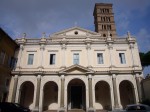 Sergius brought the cult of Saint Alexius to Rome with him where it found fertile ground since Romans love a native son. The site of the church on the Aventine even garnered an apocryphal association with Saint Alexius: it was said to be the location where his father Euphemianus’ home stood, the stairs under which he had lived in humility and poverty incorporated into the walls of the church. While he’s still a saint in the Latin Church, his cult has faded. It’s in the Eastern Church, particularly in Russia, where Alexius is one of the most venerated saints, a frequent subject of poems and stories and the reason Alexei was such a popular name for Tsars.
Sergius brought the cult of Saint Alexius to Rome with him where it found fertile ground since Romans love a native son. The site of the church on the Aventine even garnered an apocryphal association with Saint Alexius: it was said to be the location where his father Euphemianus’ home stood, the stairs under which he had lived in humility and poverty incorporated into the walls of the church. While he’s still a saint in the Latin Church, his cult has faded. It’s in the Eastern Church, particularly in Russia, where Alexius is one of the most venerated saints, a frequent subject of poems and stories and the reason Alexei was such a popular name for Tsars.
The newly restored icon plays into the legend of Saint Alexius as well. In the sexton’s vision where Mary identified Alexius as true holy man, she spoke through her icon. According to this tale, Sergius brought the icon from the church in Edessa with him when he went to Rome.






